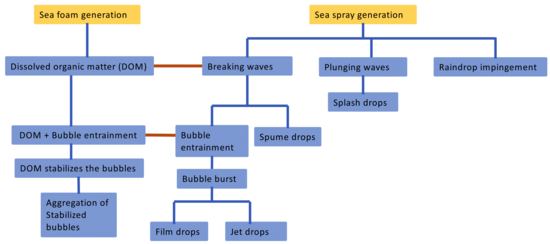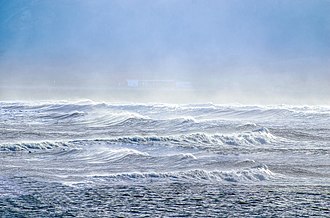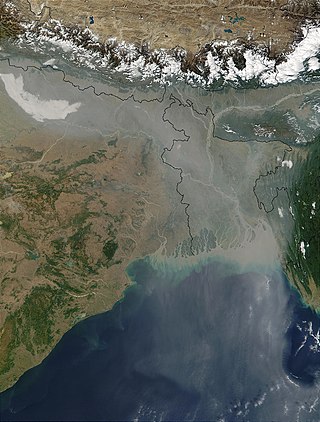
Cloud condensation nuclei (CCNs), also known as cloud seeds, are small particles typically 0.2 µm, or one hundredth the size of a cloud droplet. CCNs are a unique subset of aerosols in the atmosphere on which water vapour condenses. This can affect the radiative properties of clouds and the overall atmosphere. Water requires a non-gaseous surface to make the transition from a vapour to a liquid; this process is called condensation.

A polynya is an area of open water surrounded by sea ice. It is now used as a geographical term for an area of unfrozen seawater within otherwise contiguous pack ice or fast ice. It is a loanword from the Russian полынья, which refers to a natural ice hole and was adopted in the 19th century by polar explorers to describe navigable portions of the sea.
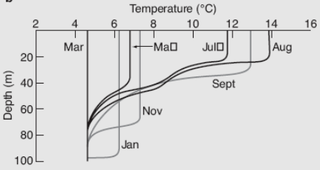
The oceanic or limnological mixed layer is a layer in which active turbulence has homogenized some range of depths. The surface mixed layer is a layer where this turbulence is generated by winds, surface heat fluxes, or processes such as evaporation or sea ice formation which result in an increase in salinity. The atmospheric mixed layer is a zone having nearly constant potential temperature and specific humidity with height. The depth of the atmospheric mixed layer is known as the mixing height. Turbulence typically plays a role in the formation of fluid mixed layers.

The Saharan Air Layer (SAL) is an extremely hot, dry and sometimes dust-laden layer of the atmosphere that often overlies the cooler, more-humid surface air of the Atlantic Ocean. It carries upwards of 60 million tonnes of dust annually over the ocean and the Americas. This annual phenomenon sometimes cools the ocean and suppresses Atlantic tropical cyclogenesis.

The sea surface microlayer (SML) is the boundary interface between the atmosphere and ocean, covering about 70% of Earth's surface. With an operationally defined thickness between 1 and 1,000 μm (1.0 mm), the SML has physicochemical and biological properties that are measurably distinct from underlying waters. Recent studies now indicate that the SML covers the ocean to a significant extent, and evidence shows that it is an aggregate-enriched biofilm environment with distinct microbial communities. Because of its unique position at the air-sea interface, the SML is central to a range of global marine biogeochemical and climate-related processes.

Tropospheric ozone depletion events are phenomena that reduce the concentration of ozone in the earth's troposphere. Ozone (O3) is a trace gas which has been of concern because of its unique dual role in different layers of the lower atmosphere. Apart from absorbing UV-B radiation and converting solar energy into heat in the stratosphere, ozone in the troposphere provides greenhouse effect and controls the oxidation capacity of the atmosphere.

Marine cloud brightening also known as marine cloud seeding and marine cloud engineering is a proposed solar radiation management climate engineering technique that would make clouds brighter, reflecting a small fraction of incoming sunlight back into space in order to offset anthropogenic global warming. Along with stratospheric aerosol injection, it is one of the two solar radiation management methods that may most feasibly have a substantial climate impact. The intention is that increasing the Earth's albedo, in combination with greenhouse gas emissions reduction, carbon dioxide removal, and adaptation, would reduce climate change and its risks to people and the environment. If implemented, the cooling effect is expected to be felt rapidly and to be reversible on fairly short time scales. However, technical barriers remain to large-scale marine cloud brightening. There are also risks with such modification of complex climate systems.

Iberulites are a particular type of microspherulites that develop in the atmosphere (troposphere), finally falling to the earth's surface. The name comes from the Iberian Peninsula where they were discovered.

Frost flowers are ice crystals commonly found growing on young sea ice and thin lake ice in cold, calm conditions. The ice crystals are similar to hoar frost, and are commonly seen to grow in patches around 3–4 cm in diameter. Frost flowers growing on sea ice have extremely high salinities and concentrations of other sea water chemicals and, because of their high surface area, are efficient releasers of these chemicals into the atmosphere.
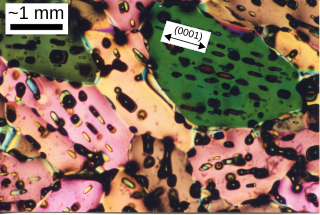
Sea ice is a complex composite composed primarily of pure ice in various states of crystallization, but including air bubbles and pockets of brine. Understanding its growth processes is important for climate modellers and remote sensing specialists, since the composition and microstructural properties of the ice affect how it reflects or absorbs sunlight.
In fluid dynamics, wave setup is the increase in mean water level due to the presence of breaking waves. Similarly, wave setdown is a wave-induced decrease of the mean water level before the waves break. For short, the whole phenomenon is often denoted as wave setup, including both increase and decrease of mean elevation. This setup is primarily present in and near the coastal surf zone. Besides a spatial variation in the (mean) wave setup, also a variation in time may be present – known as surf beat – causing infragravity wave radiation.

Sea salt aerosol, which originally comes from sea spray, is one of the most widely distributed natural aerosols. Sea salt aerosols are characterized as non-light-absorbing, highly hygroscopic, and having coarse particle size. Some sea salt dominated aerosols could have a single scattering albedo as large as ~0.97. Due to the hygroscopy, a sea salt particle can serve as a very efficient cloud condensation nuclei (CCN), altering cloud reflectivity, lifetime, and precipitation process. According to the IPCC report, the total sea salt flux from ocean to atmosphere is ~3300 teragrams (Tg) per year.

Regional Ocean Modeling System (ROMS) is a free-surface, terrain-following, primitive equations ocean model widely used by the scientific community for a diverse range of applications. The model is developed and supported by researchers at the Rutgers University, University of California Los Angeles and contributors worldwide.

Anne Mee Thompson is an American scientist, who specializes in atmospheric chemistry and climate change. Her work focuses on how human activities have changed the chemistry of the atmosphere, climate forcing, and the Earth's oxidizing capacity. Thompson is an elected fellow of the American Meteorological Society, American Geophysical Union, and AAAS.

The North Atlantic Aerosols and Marine Ecosystems Study (NAAMES) was a five-year scientific research program that investigated aspects of phytoplankton dynamics in ocean ecosystems, and how such dynamics influence atmospheric aerosols, clouds, and climate. The study focused on the sub-arctic region of the North Atlantic Ocean, which is the site of one of Earth's largest recurring phytoplankton blooms. The long history of research in this location, as well as relative ease of accessibility, made the North Atlantic an ideal location to test prevailing scientific hypotheses in an effort to better understand the role of phytoplankton aerosol emissions on Earth's energy budget.

Saharan dust is an aeolian mineral dust from the Sahara desert, the largest hot desert in the world. The desert spans just over 9 million square kilometers, from the Atlantic Ocean to the Red Sea, from the Mediterranean sea to the Niger River valley and the Sudan region in the south.

The boron cycle is the biogeochemical cycle of boron through the atmosphere, lithosphere, biosphere, and hydrosphere.
Patricia K. Quinn is a atmospheric chemist working at the National Oceanic and Atmospheric Agency's Pacific Marine Environmental Lab. She is known for her work on the impact of atmospheric aerosol particles on air quality and climate.
The sea surface skin temperature (SSTskin), or ocean skin temperature, is the temperature of the sea surface as determined through its infrared spectrum (3.7–12 μm) and represents the temperature of the sublayer of water at a depth of 10–20 μm. High-resolution data of skin temperature gained by satellites in passive infrared measurements is a crucial constituent in determining the sea surface temperature (SST).
Patricia Ana Matrai is a marine scientist known for her work on the cycling of sulfur. She is a senior research scientist at Bigelow Laboratory for Ocean Sciences.

